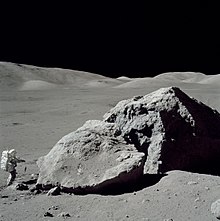Wikijunior:Solar System/Moon
 |
Moon Facts |
| |

How big is the moon?[edit | edit source]

Most of the planets in the Solar System are much bigger than their moons, but the Earth and the Moon are much closer in size. The Moon is just under 3,500 kilometers (km) wide. That's over a quarter of the size of the Earth (about 12,600 km wide) as you can see in the picture below. Because of this, the Earth and Moon together are sometimes called a binary or double planet system.
| The Solar System |
|
Introduction |
What is the moon's surface like?[edit | edit source]


The Moon has no atmosphere. It also has no liquid water on its surface. During the day it becomes very hot, but at night it is icy cold. A person visiting the Moon needs an air supply and a special suit.
The Moon has many craters on its surface. The largest one is called the South Pole-Aitken Basin and is roughly 2500 km across.
We think nearly all the craters on moons or planets were made by huge rocks hitting them a long time ago. These collisions are called impacts.
Some of the craters on the Moon look as if they have rays coming out of them. These rays are rocks thrown across the Moon by the impacts that made the craters. Some of the craters around the poles of the Moon may have ice in them.
There are also darker areas called maria (said "MARR-ee-ah"). These are large pools of lava that cooled a long time ago. Most maria are on the side of the Moon we see from Earth. The lighter areas on the Moon are highlands.
How long is the Moon's revolution?[edit | edit source]
The Moon takes just over 27 Earth days to rotate (rotate means spin around) once.
How long is a year on the moon?[edit | edit source]
The Moon also takes just over 27 days to orbit (move around) the Earth. This is why we always see the same side of the Moon when we look from the Earth. We call this side the near side. The other side we call the far side. In 1959, a probe called Luna 3 sent back pictures of the far side. That was the first time anyone saw what it looked like.
What is the Moon made of?[edit | edit source]
The surface of the Moon is made of rocks and dust. The outer layer of the Moon is called the crust. The crust is about 70 km thick on the near side and 100 km thick on the far side. It is thinner under the maria and thicker under the highlands. There may be more maria on the near side because the crust is thinner. It was easier for lava to rise up to the surface.
We think the Moon has a small core (center) about 300 km across. The core is composed of solid iron. Because the core is solid, the Moon does not have its own magnetic field.
How much would the Moon's gravity pull on me?[edit | edit source]
If you were on the Moon, it would pull you down about a sixth as much as the Earth does, so you'd weigh a sixth as much. So would anything else. That's why it was much easier for the astronauts visiting the Moon to pick up rocks there.
Who is the moon named after?[edit | edit source]

The names Moon and month both come from the ancient Greek name for the Moon, Mene. There have been other names for the Moon, like Selene and Luna. Selene was the Greek goddess of the Moon. Luna was the Roman goddess of the Moon. The Roman people also associated their goddess Diana with the Moon.
Who discovered the Moon?[edit | edit source]
Ancient Greece and Ancient China noted over 2000 years ago that the light from the Moon is reflected from the Sun. Also, Ancient Greece noted that the Moon causes tides on Earth. More recently, Luna 1 was the first spacecraft to perform a flyby of the moon. Luna 2 was the first spacecraft to land on the moon, and Luna 3 was the first to photograph the far side of the Moon which you can not see from Earth. Luna 1 through 3 all were launched in 1959. Surveyor 3, in 1967, was the first to examine the soil of the Moon. It dug to 17.5 cm. In 1969, Apollo 11 was the very first spacecraft to land people on the moon.
References[edit | edit source]
"The Moon is just under..." [1] [2]
"So the Earth and the Moon together..." [3] [4]
"The Moon does not have any atmosphere." [5] [6]
"During the day it becomes..." [7] [8]
"The largest one is called..." [9] [10]
"These rays are rocks..." [11]
"Some of the craters around the bottom..." [12] [13]
"There are also darker areas..." [14] [15]
"The lighter areas..." [16]
"The Moon takes just over 27..." [17] [18]
"We call this side..." [19] [20] [21]
"The other side we call..." [22] [23]
"The surface of the Moon..." [24] [25] [26] [27]
"...it would pull you down..." [28] [29]
"The names "Moon" and..." [30] [31] [32]